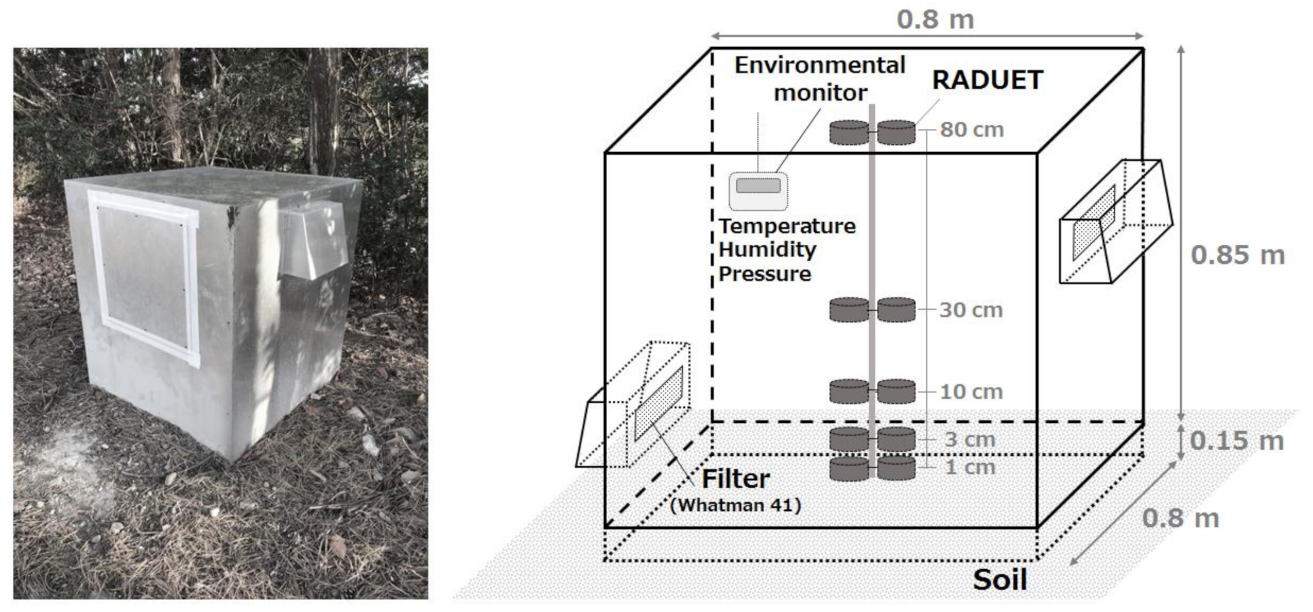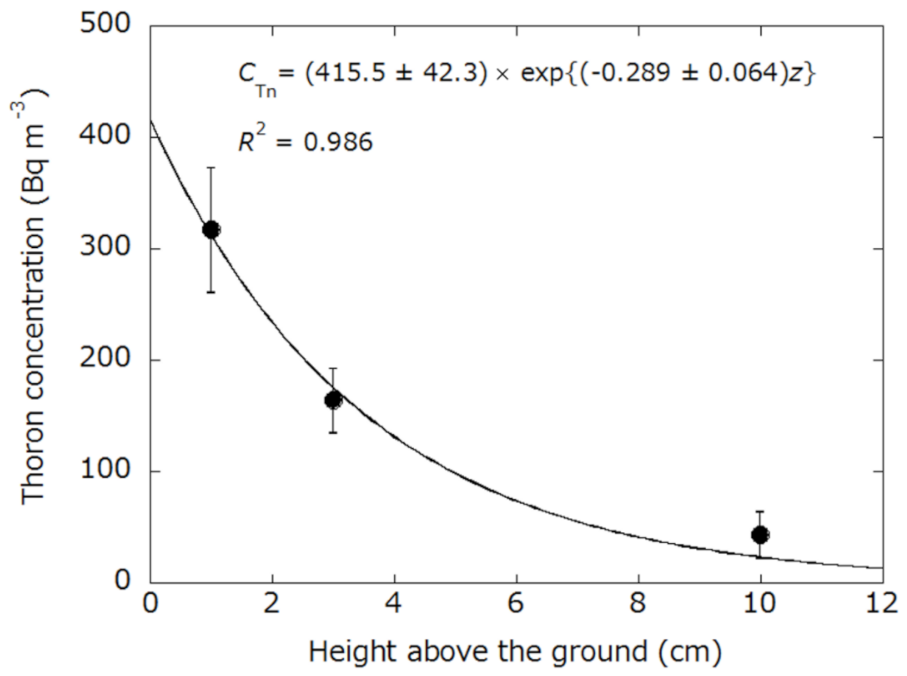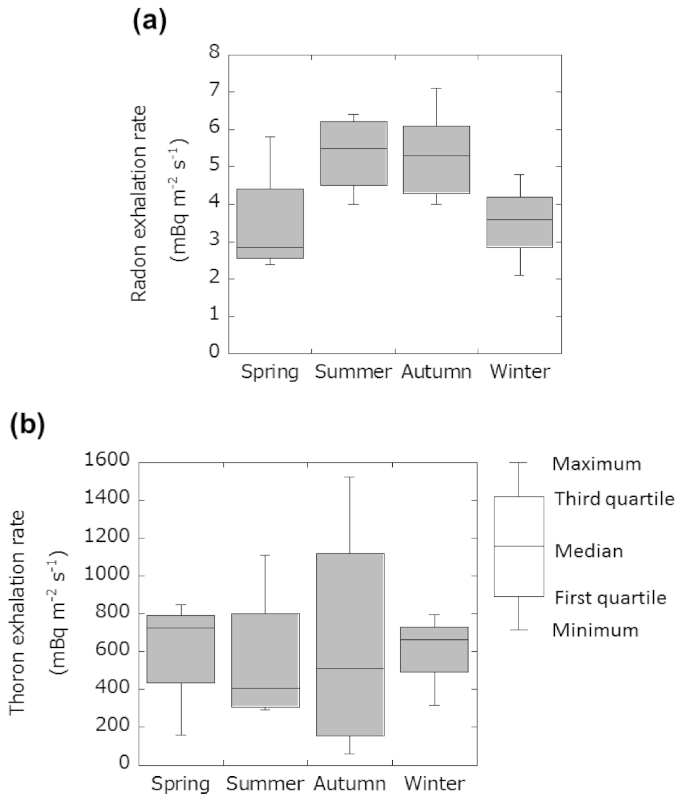Long-Term Measurements of Radon and Thoron Exhalation Rates from the Ground Using the Vertical Distributions of Their Activity Concentrations
Abstract
1. Introduction
2. Materials and Methods
2.1. Ventilated-Type Accumulation Chamber System for Measuring Radon-Thoron Exhalation Rates from the Ground
2.2. Evaluation of Radon and Thoron Exhalation Rates Using the Ventilated Type Accumulation Chamber
2.3. Soil Parameters and Its Activity Concentrations of 226Ra and 228Ra
2.4. Comparison of the Exhalation Rates with the Other Methods
2.4.1. Accumulation Chamber with Scintillation Cell
2.4.2. In Situ Radon and Thoron Exhalation Rate Monitor
3. Results and Discussion
3.1. Physical Parameters of Soil and 226Ra and 228Ra Activity Concentrations at the Study Site
3.2. Radon and Thoron Concentration in the Ventilated-Type Accumulation Chamber
3.3. Comparison of Radon and Thoron Exhalation Rates Obtained by the Present System to Those Obtained by the Other Methods
3.4. Seasonal Variations of the Radon and Thoron Exhalation Rates
4. Conclusions
Author Contributions
Funding
Institutional Review Board Statement
Informed Consent Statement
Data Availability Statement
Conflicts of Interest
References
- United Nations Scientific Committee on the Effects of Atomic Radiation. UNSCEAR 2008 Report, Effects of Ionizing Radiation. Volume I: Annex B Exposures of the Public and Workers from Various Sources of Radiation; UNSCEAR: New York, NY, USA, 2010. [Google Scholar]
- World Health Organization. WHO Handbook on Indoor Radon: A Public Health Perspective; WHO: Geneva, Switzerland, 2009. [Google Scholar]
- Sanada, T.; Fujimoto, K.; Miyano, K.; Doi, M.; Tokonami, S.; Uesugi, M.; Takata, Y. Measurement of nationwide indoor Rn concentrations in Japan. J. Environ. Radioact. 1999, 45, 129–137. [Google Scholar] [CrossRef]
- Chambers, S.D.; Preunkert, S.; Weller, R.; Hong, S.B.; Humphries, R.S.; Tositti, L.; Angot, H.; Legrand, M.; Williams, A.G.; Griffiths, A.D.; et al. Characterizing Atmospheric Transport Pathways to Antarctica and the Remote Southern Ocean Using Radon-222. Front. Earth Sci. 2018, 6, 1–28. [Google Scholar] [CrossRef]
- Hwa, O.Y.; Kim, G. A radon-thoron isotope pair as a reliable earthquake precursor. Sci. Rep. 2015, 5, 1–6. [Google Scholar] [CrossRef] [PubMed]
- Igarashi, G.; Saeki, S.; Takahata, N.; Sumikawa, K.; Tasaka, S.; Sasaki, Y.; Takahashi, M.; Sano, Y. Ground-Water Radon Anomaly Before the Kobe Earthquake in Japan. Science 1995, 269, 60–61. [Google Scholar] [CrossRef] [PubMed]
- Lawrence, C.E.; Akber, R.A.; Bollhöfer, A.; Martin, P. Radon-222 exhalation from open ground on and around a uranium mine in the wet-dry tropics. J. Environ. Radioac. 2009, 100, 1–8. [Google Scholar] [CrossRef]
- Ikebe, Y.; Yamanishi, H.; Tojo, K.; Iida, T. Relationship between radon exhalation rate from ground and atmospheric radon concentration. Nippon Genshiryoku Gakkai-Shi 1993, 35, 735–738. (In Japanese) [Google Scholar]
- Zhuo, W.; Furukawa, M.; Qiuju, G.; Yoon, S.K. Soil radon flux and outdoor radon concentration in East Asia. Int. Congr. Ser. 2005, 1276, 285–286. [Google Scholar] [CrossRef]
- Zhuo, W.; Furukawa, M.; Tokonami, S. A naturally ventilated accumulator for integrating measurements of radon flux from soil. J. Nucl. Sci. Technol. 2007, 44, 1100–1105. [Google Scholar] [CrossRef]
- Hosoda, M.; Shimo, M.; Sugino, M.; Furukawa, M.; Fukushi, M. Effect of soil moisture content on radon and thoron exhalation. J. Nucl. Sci. Technol. 2007, 44, 664–672. [Google Scholar] [CrossRef]
- Hosoda, M.; Tokonami, S.; Sorimachi, A.; Ishikawa, T.; Sahoo, S.K.; Furukawa, M.; Shiroma, Y.; Yasuoka, Y.; Janik, M.; Kavasi, N.; et al. Influence of soil environmental parameters on thoron exhalation rate. Radiat. Prot. Dosim. 2010, 141, 420–423. [Google Scholar] [CrossRef]
- Griffiths, A.D.; Zahorowski, W.; Element, A.; Werczynski, S. A map of radon flux at the Australian land surface. Atmos. Chem. Phys. 2010, 10, 8969–8982. [Google Scholar] [CrossRef]
- Lucchetti, C.; Briganti, A.; Castelluccio, M.; Galli, G.; Santilli, S.; Soligo, M.; Tuccimei, P. Integrating radon and thoron flux data with gamma radiation mapping in radon-prone areas. The case of volcanic outcrops in a highly-urbanized city (Roma, Italy). J. Environ. Radioact. 2019, 202, 41–50. [Google Scholar] [CrossRef] [PubMed]
- International Commission on Radiation Units and Measurements. Report 88: Measurement and reporting of radon exposures. J. ICRU 2012, 12, 1–19. [Google Scholar]
- Doi, M.; Fujimoto, K.; Kobayashi, S.; Yonehara, H. Spatial distribution of thoron and radon concentrations in the indoor air of a traditional Japanese wooden house. Health Phys. 1994, 66, 43–49. [Google Scholar] [CrossRef]
- Tokonami, S. Why is 220Rn (Thoron) measurement important? Radiat. Prot. Dosim. 2010, 141, 335–339. [Google Scholar] [CrossRef]
- Tschiersch, J.; Meisenberg, O. The HMGU thoron experimental house: A new tool for exposure assessment. Radiat. Prot. Dosim. 2010, 141, 395–399. [Google Scholar] [CrossRef]
- Hosoda, M.; Kudo, H.; Iwaoka, K.; Yamada, R.; Suzuki, T.; Tamakuma, Y.; Tokonami, S. Characteristic of thoron (220Rn) in environment. Appl. Radiat. Isot. 2017, 120, 7–10. [Google Scholar] [CrossRef]
- Tokonami, S.; Takahashi, H.; Kobayashi, Y.; Zhuo, W.; Hulber, E. Up-to-date radon-thoron discriminative detector for a large scale survey. Rev. Sci. Instrum. 2005, 76, 113505. [Google Scholar] [CrossRef]
- Kranrod, C.; Tamakuma, Y.; Hosoda, M.; Tokonami, S. Importance of discriminative measurement for radon isotopes and its utilization in the environment and lessons learned from using the RADUET monitor. Int. J. Environ. Res.Public Health 2020, 17, 4141. [Google Scholar] [CrossRef]
- International Organization for Standardization. Measurement of Radioactivity in the Environment-Air-Radon 220: Integrated Measurement Methods for the Determination of the Average Activity Concentration Using Passive Solid-State Nuclear Track Detectors ISO16641; ISO: Geneva, Switzerland, 2014. [Google Scholar]
- Pornumpa, C.; Oyama, Y.; Iwaoka, K.; Hosoda, M.; Tokonami, S. Development of radon and thoron exposure systems at Hirosaki University. Radiat. Environ. Med. 2018, 7, 13–20. [Google Scholar]
- Katase, A.; Matsumoto, Y.; Sakae, T.; Ishibashi, K. Indoor concentrations of 220Rn and its decay products. Health Phys. 1988, 54, 283–286. [Google Scholar] [CrossRef]
- Hirst, W.; Harrison, G.E. The diffusion of radon gas mixtures. Proc. R. Soc. A 1939, 169, 573–586. [Google Scholar]
- Hosoda, M.; Sorimachi, A.; Yasuoka, Y.; Ishikawa, T.; Sahoo, S.K.; Furukawa, M.; Hassan, N.M.; Tokonami, S.; Uchida, S. Simultaneous measurements of radon and thoron exhalation rates and comparison with values calculated by UNSCEAR equation. J. Radiat. Res. 2009, 50, 333–343. [Google Scholar] [CrossRef] [PubMed]
- Japanese Standards Association. Test Methods for Particle Size Distribution of Soils JIS A 1204; JSA: Tokyo, Japan, 2020. [Google Scholar]
- Japanese Standards Association. Test Methods for Density of Soil Particles JIS A 1202; JSA: Tokyo, Japan, 2020. [Google Scholar]
- Hosoda, M.; Nugraha, E.D.; Akata, N.; Yamada, R.; Tamakuma, Y.; Sasaki, M.; Kelleher, K.; Yoshinaga, S.; Suzuki, T.; Pornumpa Tattanapongs, C.; et al. A unique high natural background radiation area—Dose assessment and perspectives. Sci. Total Environ. 2021, 750, 142364. [Google Scholar] [CrossRef] [PubMed]
- Tokonami, S.; Yang, M.; Yonehara, H.; Yamada, Y. Simple, discriminative measurement technique for radon and thoron concentrations with a single scintillation cell. Rev. Sci. Instrum. 2002, 73, 69–72. [Google Scholar] [CrossRef]
- Saegusa, J.; Yamasaki, K.; Tsujimoto, T. Development of an apparatus for measuring ground exhalatin rates of 222Rn and 220Rn. Environ. Int. 1996, 22, 483–490. [Google Scholar] [CrossRef]
- Ministry of Agriculture, Foresty and Fisheries. Available online: https://www.maff.go.jp/j/seisan/kankyo/hozen_type/h_sehi_kizyun/pdf/ntuti4.pdf (accessed on 24 January 2021). (In Japanese).
- Hillei, D. General physical characteristics of soil. In Environmental Soil Physics; Academic Press: London, UK, 2012; pp. 3–17. [Google Scholar]
- Kanda, Y. Investigation of the freely-available easy-to-use software “EZR” (Easy R) for medical statistics. Bone Marrow Transplant. 2013, 48, 452–458. [Google Scholar] [CrossRef]
- Hosoda, M.; Shimo, M.; Sugino, M.; Furukawa, M.; Minami, K.; Ejiri, K. Radon and thoron exhalation rate map in Japan. AIP Conf. Proc. 2008, 1034, 177–180. [Google Scholar]
- Zhuo, W.; Guo, Q.; Chen, B.; Chen, G. Estimating amount and distribution of radon flux density from the soil surface in China. J. Environ. Radioact. 2008, 99, 1143–1148. [Google Scholar] [CrossRef]
- Iskander, D.; Yamazawa, H.; Iida, T. Quantification of the dependency of radon emanation power on soil temperature. Appl. Radiat. Isot. 2004, 60, 971–973. [Google Scholar] [CrossRef]
- Zhuo, W.; Iida, T.; Furukawa, M. Modeling radon flux density from the Earth’s surface. J. Nucl. Sci. Technol. 2006, 43, 479–482. [Google Scholar] [CrossRef]
- Meteorological Data. Available online: http://www.data.jma.go.jp/obd/stats/etrn/ (accessed on 24 January 2021). (In Japanese).
- Prasad, G.; Ishikawa, T.; Hosoda, M.; Sorimachi, A.; Sahoo, S.K.; Kavasi, N.; Tokonami, S.; Sugino, M.; Uchida, S. Seasonal and diurnal variations of radon/thoron exhalation rate in Kanto-loam area in Japan. J. Radioanal. Nucl. Chem. 2012, 292, 1385–1390. [Google Scholar] [CrossRef]



| Intercomparison | Methods | Radon Exhalation Rate (mBq m−2 s−1) | Thoron Exhalation Rate (mBq m−2 s−1) |
|---|---|---|---|
| 1st measurement | Ventilated-type accumulation chamber | 3.6 ± 0.5 | 797 ± 336 |
| Accumulation chamber with scintillation cell | 4.6 ± 2.9 | – | |
| In situ monitor (MSZ) method | 1.1 ± 0.1 | 584 ± 103 | |
| 2nd measurement | Ventilated type accumulation chamber | 4.3 ± 0.5 | 1120 ± 321 |
| Accumulation chamber with scintillation cell | 8.8 ± 5.3 | – | |
| In situ monitor (MSZ) method | 5.1 ± 1.8 | 474 ± 177 |
Publisher’s Note: MDPI stays neutral with regard to jurisdictional claims in published maps and institutional affiliations. |
© 2021 by the authors. Licensee MDPI, Basel, Switzerland. This article is an open access article distributed under the terms and conditions of the Creative Commons Attribution (CC BY) license (http://creativecommons.org/licenses/by/4.0/).
Share and Cite
Modibo, O.B.; Tamakuma, Y.; Suzuki, T.; Yamada, R.; Zhuo, W.; Kranrod, C.; Iwaoka, K.; Akata, N.; Hosoda, M.; Tokonami, S. Long-Term Measurements of Radon and Thoron Exhalation Rates from the Ground Using the Vertical Distributions of Their Activity Concentrations. Int. J. Environ. Res. Public Health 2021, 18, 1489. https://doi.org/10.3390/ijerph18041489
Modibo OB, Tamakuma Y, Suzuki T, Yamada R, Zhuo W, Kranrod C, Iwaoka K, Akata N, Hosoda M, Tokonami S. Long-Term Measurements of Radon and Thoron Exhalation Rates from the Ground Using the Vertical Distributions of Their Activity Concentrations. International Journal of Environmental Research and Public Health. 2021; 18(4):1489. https://doi.org/10.3390/ijerph18041489
Chicago/Turabian StyleModibo, Oumar Bobbo, Yuki Tamakuma, Takahito Suzuki, Ryohei Yamada, Weihai Zhuo, Chutima Kranrod, Kazuki Iwaoka, Naofumi Akata, Masahiro Hosoda, and Shinji Tokonami. 2021. "Long-Term Measurements of Radon and Thoron Exhalation Rates from the Ground Using the Vertical Distributions of Their Activity Concentrations" International Journal of Environmental Research and Public Health 18, no. 4: 1489. https://doi.org/10.3390/ijerph18041489
APA StyleModibo, O. B., Tamakuma, Y., Suzuki, T., Yamada, R., Zhuo, W., Kranrod, C., Iwaoka, K., Akata, N., Hosoda, M., & Tokonami, S. (2021). Long-Term Measurements of Radon and Thoron Exhalation Rates from the Ground Using the Vertical Distributions of Their Activity Concentrations. International Journal of Environmental Research and Public Health, 18(4), 1489. https://doi.org/10.3390/ijerph18041489









